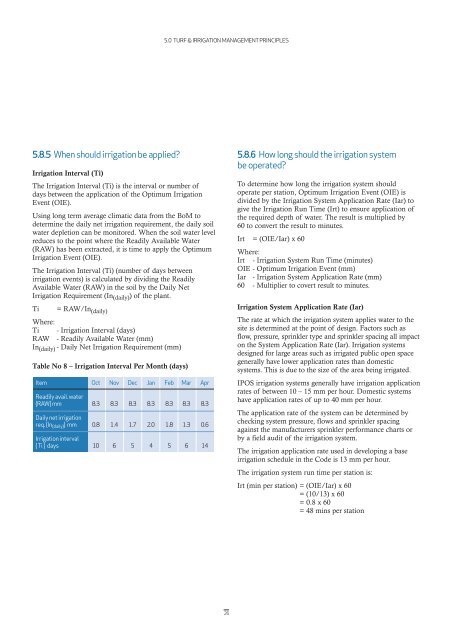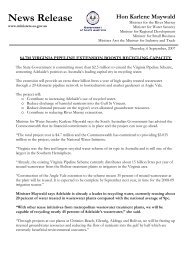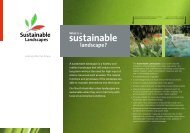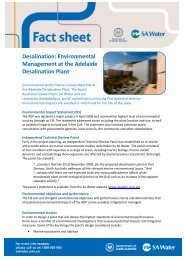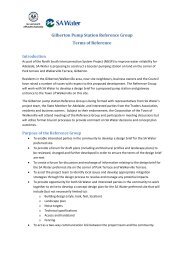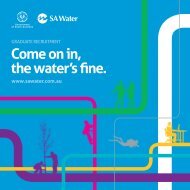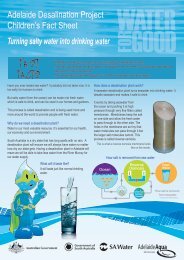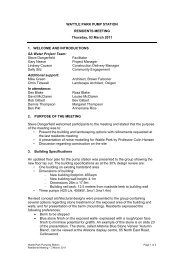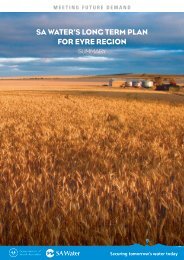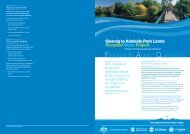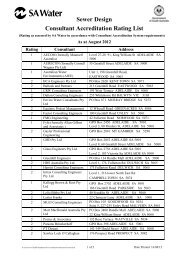Code of Practice - Irrigated Public Open Space - SA Water
Code of Practice - Irrigated Public Open Space - SA Water
Code of Practice - Irrigated Public Open Space - SA Water
Create successful ePaper yourself
Turn your PDF publications into a flip-book with our unique Google optimized e-Paper software.
5.8.5 When should irrigation be applied?<br />
Irrigation Interval (Ti)<br />
The Irrigation Interval (Ti) is the interval or number <strong>of</strong><br />
days between the application <strong>of</strong> the Optimum Irrigation<br />
Event (OIE).<br />
Using long term average climatic data from the BoM to<br />
determine the daily net irrigation requirement, the daily soil<br />
water depletion can be monitored. When the soil water level<br />
reduces to the point where the Readily Available <strong>Water</strong><br />
(RAW) has been extracted, it is time to apply the Optimum<br />
Irrigation Event (OIE).<br />
The Irrigation Interval (Ti) (number <strong>of</strong> days between<br />
irrigation events) is calculated by dividing the Readily<br />
Available <strong>Water</strong> (RAW) in the soil by the Daily Net<br />
Irrigation Requirement (In(daily)) <strong>of</strong> the plant.<br />
Ti = RAW/In (daily)<br />
Where:<br />
Ti - Irrigation Interval (days)<br />
RAW - Readily Available <strong>Water</strong> (mm)<br />
In(daily) - Daily Net Irrigation Requirement (mm)<br />
Table No 8 – Irrigation Interval Per Month (days)<br />
Item Oct Nov Dec Jan Feb Mar Apr<br />
Readily avail. water<br />
(RAW) mm 8.3 8.3 8.3 8.3 8.3 8.3 8.3<br />
Daily net irrigation<br />
req. (In(daily)) mm 0.8 1.4 1.7 2.0 1.8 1.3 0.6<br />
Irrigation interval<br />
( Ti ) days 10 6 5 4 5 6 14<br />
5.0 TURF & IRRIGATION MANAGEMENT PRINCIPLES<br />
26<br />
5.8.6 How long should the irrigation system<br />
be operated?<br />
To determine how long the irrigation system should<br />
operate per station, Optimum Irrigation Event (OIE) is<br />
divided by the Irrigation System Application Rate (Iar) to<br />
give the Irrigation Run Time (Irt) to ensure application <strong>of</strong><br />
the required depth <strong>of</strong> water. The result is multiplied by<br />
60 to convert the result to minutes.<br />
Irt = (OIE/Iar) x 60<br />
Where:<br />
Irt - Irrigation System Run Time (minutes)<br />
OIE - Optimum Irrigation Event (mm)<br />
Iar - Irrigation System Application Rate (mm)<br />
60 - Multiplier to covert result to minutes.<br />
Irrigation System Application Rate (Iar)<br />
The rate at which the irrigation system applies water to the<br />
site is determined at the point <strong>of</strong> design. Factors such as<br />
flow, pressure, sprinkler type and sprinkler spacing all impact<br />
on the System Application Rate (Iar). Irrigation systems<br />
designed for large areas such as irrigated public open space<br />
generally have lower application rates than domestic<br />
systems. This is due to the size <strong>of</strong> the area being irrigated.<br />
IPOS irrigation systems generally have irrigation application<br />
rates <strong>of</strong> between 10 – 15 mm per hour. Domestic systems<br />
have application rates <strong>of</strong> up to 40 mm per hour.<br />
The application rate <strong>of</strong> the system can be determined by<br />
checking system pressure, flows and sprinkler spacing<br />
against the manufacturers sprinkler performance charts or<br />
by a field audit <strong>of</strong> the irrigation system.<br />
The irrigation application rate used in developing a base<br />
irrigation schedule in the <strong>Code</strong> is 13 mm per hour.<br />
The irrigation system run time per station is:<br />
Irt (min per station) = (OIE/Iar) x 60<br />
= (10/13) x 60<br />
= 0.8 x 60<br />
= 48 mins per station


